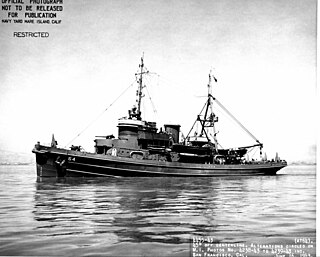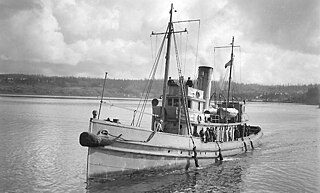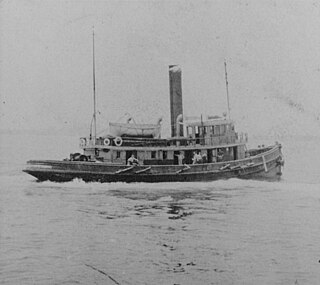The United States Navy, United States Coast Guard, and United States National Oceanic and Atmospheric Administration (NOAA) use a hull classification symbol to identify their ships by type and by individual ship within a type. The system is analogous to the pennant number system that the Royal Navy and other European and Commonwealth navies use.

USS Algonquin, completed as El Toro in 1891 for the Southern Pacific Railroad's Morgan Line, was a small harbor tug commissioned by the United States Navy 2 April 1898. Renamed Accomac, after Accomac, Virginia, June 1898, renamed Nottoway in 1918 and, after the Navy adopted alphanumeric hull numbers on 17 July 1920, classified as YT-18, a district tug. On 5 October 1942 the name was cancelled and the tug was simply YT-18 until 1944 when classification was changed to YTL-18, a little harbor tug. Over the years as a Navy tug, from 1898 to 1946, the tug served from Cuba to Boston.
USS Pocahontas (YT-266/YTB-266/YTM-266) was a type V2-ME-A1 Hiawatha-class yard tug in the United States Navy during World War II.

USS Navajo (AT-52) was the lead ship of her class of tugs in the United States Navy.

USS Navajo (AT-64) was an oceangoing tugboat in the United States Navy, and the lead ship of its class. It was named for the Navajo people. Originally called the Navajo-class of fleet tugs, it was later renamed the Cherokee-class after loss of the first two ships of the class.

USS Oriole (AM-7) was an Lapwing-class minesweeper acquired by the U.S. Navy for the dangerous task of removing mines from minefields laid in the water to prevent ships from passing.

The first USS Sioux (YT-19) was an iron-hulled tug in the United States Navy. Sioux was named after the Sioux people.

USS Challenge (SP-1015/AT-59/YT-126/YTM-126) was a commercial tugboat acquired by the United States Navy for service in World War I, and remained available for duty during World War II.
USS Bagaduce (AT-21/ATO-21) was the lead ship of the Bagaduce class of fleet tugs for the United States Navy. She was the first ship of the U.S. Navy of that name, and is named for the Bagaduce River and a peninsula in Hancock County, Maine.
USS Arapaho (AT-14/YT-121) was an Arapaho-class fleet tug that performed various tugboat services for the United States Navy. She was constructed in Seattle, Washington; however, she spent most of her working career on the U.S. East Coast, primarily at Norfolk, Virginia, and Philadelphia, Pennsylvania.
The third Mohawk (YT‑17), later renamed YT-17 and YTL-17, was a tug that served in the United States Navy from 1898 to 1946.

USS Bouker No. 2 (SP-1275), later YT-30, was a tug that served in the United States Navy from 1917 to 1921.
USS Evea (YT-458), originally the sixth USS Resolute (YT-458), later YTB-458, was a United States Navy tug in commission from 1943 to 1944.

The first USS Sappho (ID-1427) was a United States Navy ferry transport in commission from 1918 to 1919.

The first USS Tillamook, later AT-16, later YT-122, later YTM-122, was a United States Navy tug in service from 1914 to 1947.

Manhattan (YTB‑779/YT-800) is a United States Navy Natick-class large harbor tug named for Manhattan, New York.

USS Dreadnaught (ID-1951), later YT-534 and YNG-21, was a United States Navy tug that was in service from 1918 to 1944.

The Type V ship is a United States Maritime Commission (MARCOM) designation for World War II tugboats. Type V was used in World War II, Korean War and Vietnam War. Type V ships were used to move ships and barges. Type V tugboats were made of either steel or wood hulls. There were four types of tugboats ordered for World War II. The largest type V design was the sea worthy 186-foot (57 m) long steel hull, V4-M-A1. The V4-M-A1 design was used by a number of manufacturers, a total of 49 were built. A smaller steel hull tugboat was the 94-foot (29 m) V2-ME-A1, 26 were built. The largest wooden hull was the 148-foot (45 m) V3-S-AH2, which 14 where built. The smaller wooden hull was the 58-foot (18 m) V2-M-AL1, which 35 were built. Most V2-M-AL1 tugboats were sent to England for the war efforts under the lend-lease act. The Type V tugs served across the globe during Work War II including: Pacific War, European theatre and in the United State. SS Farallon and other Type V tugs were used to help built Normandy ports, including Mulberry harbour, on D-Day, June 6, 1944 and made nine round trips to Normandy to deliver Phoenix breakwaters.
Everett-Pacific Shipbuilding & Dry Dock Company was established in 1942 to build ships needed for World War 2. As part of the Emergency Shipbuilding Program the US Navy provided some of the capital to start Everett-Pacific Shipbuilding at Port Gardner Bay in Everett, Washington. Everett-Pacific was sold in 1945 to the Pacific Car and Foundry, who was already a major manufacturer of railcars and trucks. Pacific Car and Foundry was building barges for the US Navy during World War 2 at plants in Renton, Seattle and Tacoma in the state of Washington. The lease for the shipyard in Everett, Washington ended in 1949 and the yard closed. Pacific Car and Foundry in 1972 changed its name to Paccar Inc. to reflect its major products. The Everett-Pacific shipyard site later became part of Western Gear, a heavy machinery manufacturer. in 1987 the shipyard became part of Naval Station Everett. Everett-Pacific Shipbuilding was started by William Pigott, Jr. a Seattle businessmen and his brother Paul Pigott (1900-1961). William Pigott, Jr. was born in 26 Aug. 1895 in Pueblo, CO and died on 8 July 1947 in San Francisco, CA.











